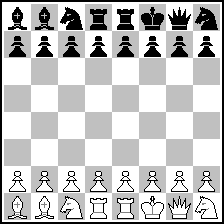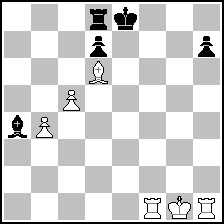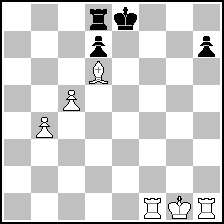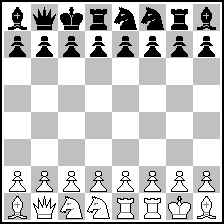|
| Page: [Previous] [Next] 1 2 3 |
| (21) Posted by Andrew Buchanan [Monday, Apr 23, 2018 20:29]; edited by Andrew Buchanan [18-04-28] |
Hi Joost,
QUOTE
For (1), h#4 would mean white starts and black delivers mate on his first move, since the conventional party (black) doesn't have the first move. So it should be h#3.5.
The "official joke", Art. 15 isn't anything to do with half-duplex. The player to mate remains the same. In the adversarial genres (d#, s#), the opponent gets an extra single move. In h#, Black loses his first move so it's really set play with no actual play.
However, I agree it's best here as h#3.5, for reasons given.
|
|
| (22) Posted by Sarah Hornecker [Tuesday, Jun 12, 2018 06:03] |
 (= 16+16 ) (= 16+16 )
SH, original
Chess960, SPG
|
|
| (23) Posted by Petko Petkov [Tuesday, Jun 12, 2018 09:18] |
This is not a legal position according to the rules of Chess-960! Pay attention to one important rule in chess-960: The king must be placed on a square between the rooks!
|
|
| (24) Posted by Frank Richter [Tuesday, Jun 12, 2018 12:48] |
I assume, this isn't a starting position, but an end position of a virtual game ... ("SPG")
|
|
| (25) Posted by Petko Petkov [Tuesday, Jun 12, 2018 14:15] |
But perhaps there is something unclear!?
|
|
| (26) Posted by Petko Petkov [Tuesday, Jun 12, 2018 16:04] |
If the starting position is SQRBBKRS possible is 1.Sh1-g3 Sa8-b6 2.0-0 Qb8-a8 3.Kg1-h1 Rc8-b8 4.Rf1-g1 Sb6-c8 5.Sg3-f1 dia therefore SPG 4,5 (if the white castling is not possible on the first move - in this case there is a dual after 1.0-0).
|
|
| (27) Posted by Sarah Hornecker [Wednesday, Jun 13, 2018 06:19] |
You solved it correctly. Yes, I didn't see that dual.
|
|
| (28) Posted by Andrew Buchanan [Saturday, Jun 16, 2018 18:44]; edited by Andrew Buchanan [18-06-16] |
This is sound, but no longer than the previous one.
 (= 16+16 ) (= 16+16 )
Original SPG Chess960
C+ Jacobi
|
|
| (29) Posted by Geir Sune Tallaksen Østmoe [Friday, Aug 24, 2018 22:00] |
Thanks for all your replies to my original question! Since then, I have composed and published a little Chess960 study.
Geir Sune Tallaksen Østmoe
Aftenposten 2018
 (= 5+3 ) (= 5+3 )
Chess960
Win
1.c5 Bxd7 2.0-0-0! Kf8 3.Rxd7! Rxd7 4.c6 Ke7 5.b7 wins.
In standard chess, 2.Rd1 with the same idea would have worked, but here this fails to 2...0-0-0! White has to play 2.0-0-0 so that Black can no longer castle.
|
|
| (30) Posted by seetharaman kalyan [Saturday, Aug 25, 2018 20:09] |
I thought in Chess 960 the king still moves two squares only to castle... so for 2. ooo won't the king will move to e1 and the rook to f1.
|
|
| (31) Posted by Kostas Prentos [Sunday, Aug 26, 2018 01:48] |
The castling rules in Chess960 are (have to be) special. Check the following link for details: https://en.wikipedia.org/wiki/Chess960
|
|
| (32) Posted by Andrew Buchanan [Monday, May 11, 2020 13:05]; edited by Andrew Buchanan [20-06-08] |
I thought we must have already found the longest Chess960 SPG, where all pieces are on their first and second ranks. But apparently not!
 (= 16+16 ) (= 16+16 )
(16+16) Chess 960 SPG
C+ Jacobi
Paradoxically for a Chess960 position, this is symmetrical. Normally since we don't know the starting position, we would have different line-ups for White and Black to force a common starting array. But not in this one! :-)
|
|
| (33) Posted by Sarah Hornecker [Monday, Jun 1, 2020 16:46]; edited by Sarah Hornecker [20-06-01] |
 (= 6+5 ) (= 6+5 )
(version:  (= 6+4 ) (= 6+4 )
)
SH, Original
After Rafael Kofman
White retracts one move, then checkmates in exactly 2 moves.
White retracts 1.0-0 (Kf1, Rg1). Retracting this move, however, does not prove that the castling was actually a legal move, so White plays 1.0-0. Black has no defense against the checkmate next move, as by castling White proved that the king started on f1.
In the version, there is a try that fails only because retracting the castling wouldn't prove it is actually legal. But I think that is not how the Codex works anymore?
|
|
| (34) Posted by Andrew Buchanan [Tuesday, Jun 2, 2020 03:46]; edited by Andrew Buchanan [20-06-02] |
Hi Siegfried,
Without examining your problem in detail, here's my understanding of the conventions. Let's put Chess960 down for a minute.
(1) The castling & en passant conventions, covering the two orthodox classes of conditional moves, apply only to forward stipulations. Before applying them, you must squeeze all possible retro logic conclusions. The castling convention is "optimistic" - by default "yes you can"; while the en passant convention is "pessimistic" - unless you can prove the last move was the double hop "no you can't".
(2) In general retro problems (e.g. "Last move?") the conventions don't apply at all. You can only retract a move if you can prove that it is the unique possibility. This applies to both legal and conditional moves. If you prove that the last move was a certain conditional move, then the game state must have been such so that the move was playable.
(3) In retractors, *any* legal or conditional last move may be retracted, again without recourse to the conventions. If you choose to retract a conditional move, again the game state must have been such that the move was playable. E.g. you don't have to castle again in a forward direction to "prove it".
So how do these apply to castling in Chess960? There is no explicit mention of Chess960 in the Conventions yet. As earlier discussion in this forum explored, there are really *two* aspects of Chess960 castling game state:
(a) position of K & R in initial game array,
(b) whether these pieces moved earlier in the game.
In principle these should be treated differently, but in practice they are lumped together.
Let's see how they will be treated in the three cases listed above.
Case (1) If castling rights might be preserved. then forward castling is allowed.
Case (2) in a general retro, universal pessimism applies. You must prove everything before being able to conclude the last move. That includes deducing the original squares of K & R, if castling is retracted.
Case (3) in a retractor (as here) universal optimism applies. You can retract anything possible, and then if a castling was retracted, deduce what the starting squares of K & R must have been.
Help-retractors (like the example here) are hybrids. There is a retraction phase case (3) after which we have some knowledge of the game state, and then can pass to a forward phase. What happens? Well we begin with case (3), and then following the retraction, we have some knowledge of the game state, which will constrain forward moves. In principle, any *residual* uncertainty (e.g. is some en passant move ok?) in theory would be addressed by case (1). That refinement isn't needed here.
As far as I know here is no site where the above explanation of conventions is given. In its absence, every person interested in serious non-Smullyan retro has to struggle through and figure it out for themselves. The Retro Corner might have been such a place, and might still be again if an energetic editor can be given write access to clean it up (and put a new coat of paint on, it's a bit drab!)
|
|
| (35) Posted by Sarah Hornecker [Wednesday, Jun 3, 2020 08:43]; edited by Sarah Hornecker [20-06-03] |
Dear Andrew,
I will send you the Kofman problem.
https://www.chess.com/forum/view/more-puzzles/4-help-retractors
It is at the posting #12 here. I saw it first in Tim Krabbé's book, many years ago.
Of course, by modern rules, it is "cooked" (or rather has a second solution), as Arisktotle mentions there. Also interesting is post #20.
So my aim was not to create necessarily a correct problem by today's standards (as I mentioned, the Codex disagrees with Kofman's reasoning) but to "transform" Kofman's problem into Chess960. :-)
|
|
| (36) Posted by Sarah Hornecker [Friday, Jun 5, 2020 07:46]; edited by Sarah Hornecker [20-06-05] |
I would like to take the opportunity to correct my 2018 problem as follows:
 (= 16+16 ) (= 16+16 )
SPG
Chess960
Intended solution:
==========
bqnrknrb/pppppppp/8/8/8/8/PPPPPPPP/BQNRKNRB
1.Ne3 Nd6 2.0-0 0-0-0 3.Rde1 Ne8 4.Nd1
==========
Mark to see
Markup for invisibility is "w": http://www.matplus.net/start.php?px=1266729709&app=forum&act=posts&fid=xshows&tid=57&pid=1728#n1728
|
|
| (37) Posted by Andrew Buchanan [Monday, Jun 8, 2020 11:15] |
Hi Siegfried,
Your SPG is sound and terse. Sorry I've not responded to the convention question yet: anything involving Arisktotle is exhausting.
|
|
| (38) Posted by James Malcom [Monday, Jun 8, 2020 12:36]; edited by James Malcom [20-06-08] |
I can comfirm that one Andrew! And so part of Arisktotle’s name us “Kofman,” ey?
|
|
| (39) Posted by Andrew Buchanan [Monday, Jun 8, 2020 12:41] |
Arisktotle is not Kofman
|
|
| (40) Posted by James Malcom [Monday, Jun 8, 2020 13:04] |
Ah, my miatake.
|
|
Read more... |
Page: [Previous] [Next] 1 2 3
MatPlus.Net  Forum Forum  General General  Chess960 problems? Chess960 problems? |
 ISC 2024
ISC 2024 Forum
Forum  General
General  Chess960 problems?
Chess960 problems? 


